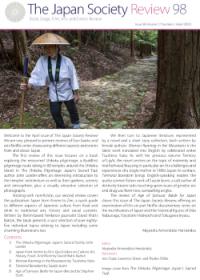The Japan Society Review
The Japan Society Review is an digital publication covering Japan-related books and films, as well as theatre and stage productions, tv series and exhibitions. Published since 2006, it is released now on a quarterly basis and is available online on our website and printed for members. Its purpose is to inform, entertain and encourage readers to explore the works for themselves.
The Japan Society Review is possible thanks to the work of volunteers who dedicated their time and expertise to help us to promote the learning and understanding of Japanese culture and society.
To become a reviewer, please fill the form here and let us know a little about you, your professional or academic background, your interest, passion or expertise regarding Japan and the type of works you would like to review.
If you have any questions, please contact reviews@japansociety.org.uk.
Books
The Japanese Myths: A Guide to Gods, Heroes, and SpiritsBy Joshua Frydman This book is a wonderful guide to an enduring fascination with stories and the supernatural in Japan. Frydman’s explanations prove mythology acts as a compass to guide past, present and future generations. Review by Renae Lucas-Hall
Books
Designing Modern JapanBy Sarah Teasley Designing Modern Japan is jargon free, easy to read and a thoroughly researched book, packed full of great illustrations that take us on a journey from the middle of the 19th century to present day. Review by David Tonge
Books
All the Lovers in the NightBy Kawakami Mieko On the whole, All the Lovers in the Night is a novel which will draw you in with its poetry and prose, and make you dissect it line by line in much the same way as its protagonist does in her work. Review by Cameron Bassindale
Issues (PDF)
Issue 98 (April 2022, Volume 17, Number 2)Welcome to the April issue of The Japan Society Review! We are very pleased to present reviews of four books and one Netflix series showcasing different aspects and stories from and about Japan.
Books
Terminal BoredomBy Suzuki Izumi Taken as a whole, Terminal Boredom comes on like a high-intensity cocktail of distinctly bizarre tales that invariably, through a particularly slanted, satire-driven look at issues of gender, sex and drug use, force us to see the familiar from new, compelling angles. Review by Laurence Green
Books
Woman Running in the MountainsBy Tsushima Yuko The New York Review of Books’ edition of Woman Running in the Mountains is simultaneously a novel that you could recommend to a first time reader of Japanese literature, and to a seasoned longtime lover who feels they’ve read everything there is to offer from those works available in English translation. Review by Laurence Green
Issues (PDF)
Issue 97 (February 2022, Volume 17, Number 1)This issue of The Japan Society Review marks the opening of an exciting new year of Japan-related books, films and events. In 2022 this publication will reach a landmark 100 issues, an inspiring moment in our ongoing mission to celebrate the vibrancy and variety of Japanese culture, history, politics and much more.
Books
Fish Swimming In Dappled SunlightBy Onda Riku Time and again, Onda Riku forces us to confront the ugly truths behind the questions: Who are we really? What drives us to act the way we do? And can we ever know the inner thoughts of another? Review by Laurence Green
Books
Of Arcs and Circles: Insights from Japan on Gardens, Nature, and ArtBy Marc Peter Keane From his vantage point as a garden designer and writer based in Kyoto, Marc Peter Keane examines the world around him and delivers astonishing insights through an array of narratives. Review by Katie Croft
Books
The Wagamama Bride: A Jewish Family Saga Made in JapanBy Liane Grunberg Wakabayashi This compelling and insightful memoir reads like a classic love story full of trials and tribulations. Liane Grunberg Wakabayashi’s spiritual journey in Japan from secular to orthodox Judaism is a reflection on transformation, relationships, family values, finding happiness, and being true to oneself. Review by Renae Lucas-Hall











